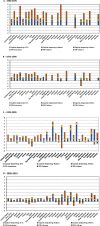Growth Factors in Developed Countries: A 1960-2019 Growth Accounting Decomposition
- PMID: 34725536
- PMCID: PMC8552436
- DOI: 10.1057/s41294-021-00170-3
Growth Factors in Developed Countries: A 1960-2019 Growth Accounting Decomposition
Abstract
Using a new and original database, our paper contributes to the growth accounting literature with three original aspects: First, it covers a long period from the early 60's to 2019, just before the COVID-19 crisis; second, it analyzes a large set of economies (30 plus the Euro Area) at the country level; finally, it singles out the growth contribution of information and communications technologies (ICTs) capital as well as robots. Our findings show that the main drivers of labor productivity growth over the whole 1960-2019 period appear to have been education, total factor productivity (TFP), non-ICT and non-robot capital deepening. The relative contribution of ICT capital is found to be declining from the mid-2000s, although our country-level economy dataset does not make it possible to estimate the TFP contribution of ICTs. The contribution of robots to productivity growth through capital deepening and TFP appears to be significant in Germany and Japan in the sub-period 1975-1995, in France and Italy in 1995-2005, and in several Eastern European countries in 2005-2019. Our findings also confirm the slowdown in TFP in most countries from at least 1995 onwards. This slowdown is mainly accounted for by a decrease in the contributions of non-ICT non-robot capital deepening and TFP.
Keywords: Growth; ICTs; Productivity; Robots.
© Association for Comparative Economic Studies 2021.
Figures

















References
-
- Acemoglu D, Restrepo P. Robots and jobs: Evidence from US labor markets. Journal of Political Economy. 2020;128(6):2188–2244. doi: 10.1086/705716. - DOI
-
- Acemoglu D, Lelarge C, Restrepo P. Competing with robots: Firm-level evidence from France. American Economic Review, Papers and Proceedings. 2020;110:383–388. doi: 10.1257/pandp.20201003. - DOI
-
- Aghion P, Askenazy P, Bourlès R, Cette G, Dromel N. Education, market rigidities and growth. Economics Letters. 2009;102(1):62–65. doi: 10.1016/j.econlet.2008.11.025. - DOI
-
- Ahmad N, Schreyer P. Are GDP and productivity measures up to the challenges of the digital economy? International Productivity Monitor. 2016;30:4–27.
-
- Andrews, D., C. Criscuolo and P.N. Gal. 2016. The best versus the rest: The global productivity slowdown, divergence across firms and the role of public policy. OECD productivity working papers, 2016–05. Paris: OECD Publishing, .
LinkOut - more resources
Full Text Sources
